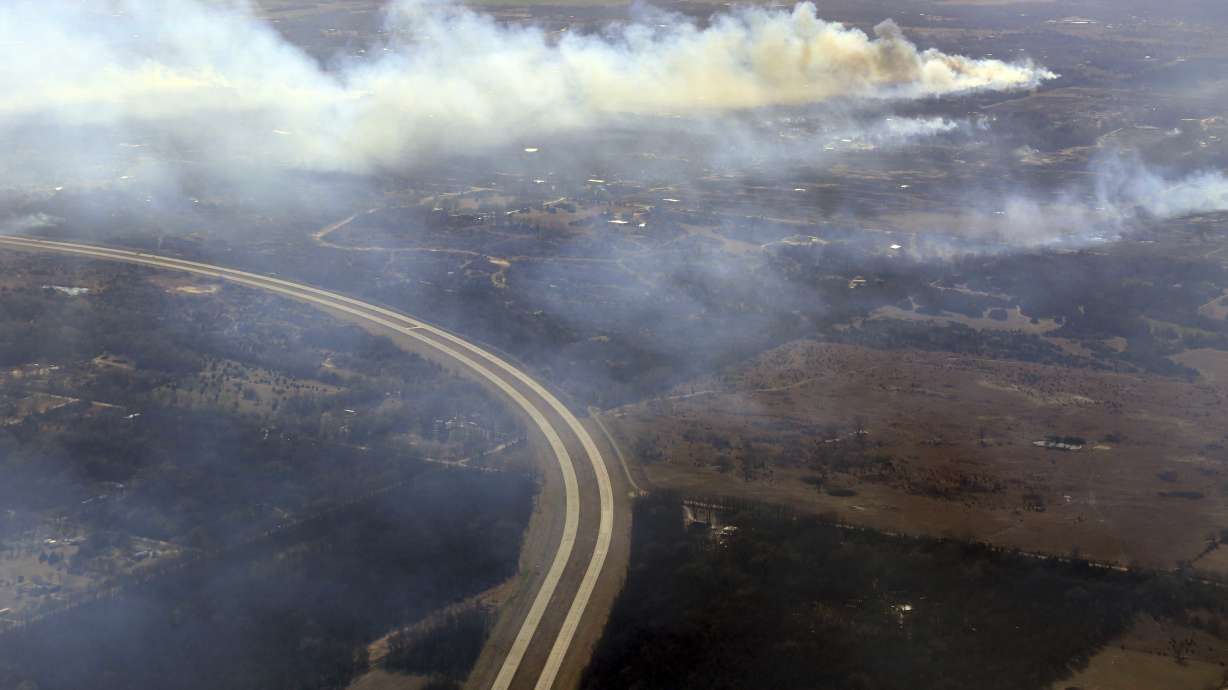Estimated read time: 4-5 minutes
This archived news story is available only for your personal, non-commercial use. Information in the story may be outdated or superseded by additional information. Reading or replaying the story in its archived form does not constitute a republication of the story.
KANSAS CITY, Mo. (AP) — Wildfires scorching hundreds of square miles of Kansas, Colorado, Texas and Oklahoma have been blamed in at least six deaths as of Wednesday. Thousands of people have been displaced by the wind-whipped flames.
Here's a look at the situation:
WHAT'S BURNING?
A two-county wildfire in Kansas has consumed an estimated 861 square miles of land, eclipsing last year's record for the biggest single blaze in the state's recorded history. Kansas Division of Emergency Management spokeswoman Katie Horner says the estimated 625 square miles charred in Clark County as of Wednesday is about 85 percent of that county's total land, with an additional 236 square miles lost in Comanche County. Horner tells The Associated Press that that number in the two predominantly ranching-and-farming counties appears certain to grow. The previous record for the most-widespread Kansas blaze came last year, with the Anderson Creek fire in Barber and Comanche counties consuming 488 square miles of land.
Horner says that since last Saturday, large grassfires have been reported in 23 Kansas counties, consuming more than 1,000 square miles. At least 70 structures in Kansas have been damaged or destroyed.
In addition, three wildfires in the Texas Panhandle have burned nearly 750 square miles of rural land, while more than 540 square miles of property has been blackened in Oklahoma. Dozens of square miles also have been charred in northeastern Colorado.
WHAT CAUSES SUCH BLAZES?
It's not yet clear what sparked the wildfires now raging.
But Bill Bunting, forecast operations chief at the Storm Prediction Center in Norman, Oklahoma, said human activity causes most wildfires in the prairie — a cigarette thrown from a car or sometimes a spark from a catalytic converter. Bunting said lightning accounts for 25 percent of wildfires.
WHAT'S STOKING THE FLAMES?
Parched conditions amplified by strong winds and low humidity put the region at risk for wildfires. All of eastern Colorado is classified as either moderately or abnormally dry along with much of Kansas and Oklahoma, and some of northern Texas, according to the U.S. Drought Monitor, a weekly tracker of dry conditions across the U.S.
Noting the abundance of vegetation fuel, drought conditions and windiness in the southern central Plains, Liz Leitman, a Storm Prediction Center meteorologist, said Wednesday that "everything has come together to overlap to create a pretty volatile situation."
PROMISING WEATHER AHEAD
Firefighters in many of the affected states may catch a break within days.
Brian Fuchs, a climatologist with the Nebraska-based National Drought Mitigation Center, said the weekly drought report he put together for release Thursday will show an intensification of drought conditions in the fire-ravaged region.
But perhaps starting late Thursday and lingering into the weekend, a storm is forecast to drop an inch or more of rainfall from central Kansas through much of Oklahoma and Texas, Fuchs said. The Texas Panhandle, eastern Colorado and western Kansas may miss out on that.
"That will be enough precipitation to put the brakes on some of this (wildfire outbreak) right now," he said.
COULD THE OUTBREAK BE CYCLICAL?
Leitman said the latest outbreak of wildfires "seems to be, at least in my experience, a naturally occurring cycle for this area" and "not unusual for this time of year."
She said the last large outbreak came in late 2010 and into 2011, when similar conditions caused wildfires that scorched more than 4,000 square miles in Texas and Arizona.
COULD CLIMATE CHANGE BE IN PLAY?
In 2013, University of Illinois atmospheric sciences professor Don Wuebbles warned that the frequency and intensity of wildfires likely would increase in the coming years, given the confluence of such factors as higher temperatures, untamed underbrush and less rain.
Wuebbles, a co-author of a draft federal report linking climate change to an increase in severe weather trends, postulated then to National Geographic that "this probably is the new normal."
"Thirty years from now, we may look upon this as being a much better period than what we may be facing then," he said then.
WHAT'S THE COST?
Officials in the states affected by the ongoing wildfires haven't released estimates of the economic losses from damaged or destroyed homes, businesses and livestock — or the expense of firefighters' efforts to knock down the flames. But it's expected those costs will run well into the millions of dollars.
During last year's massive wildfire along the Kansas-Oklahoma border, for example, firefighting costs reached $1.5 million in Barber County — the Kansas county hardest hit by that blaze. That county's emergency management chief, Jerry McNamar, said the county's economic losses included 750 to 800 cattle that died in the county, along with at least 2,700 miles of fence, worth $27 million, that was destroyed.
GLASS HALF FULL
Wildfires can offer some ecological benefits.
Conservation experts, for instance, say that last year's sprawling Oklahoma-Kansas blaze managed to clear out more eastern red cedars in a week than local efforts to eradicate that invasive species could have accomplished in decades.
Red cedars, also known as junipers, are fast-growing, drought-resistant trees that are useful for erosion control along canyon edges in the region's Red Hills. But those trees — often the focus of prescribed burns — are a nuisance on prairie land because they crowd out native grasses, suck up moisture from the soil and reduce the amount of forage area for wildlife and livestock.
Copyright © The Associated Press. All rights reserved. This material may not be published, broadcast, rewritten or redistributed.








